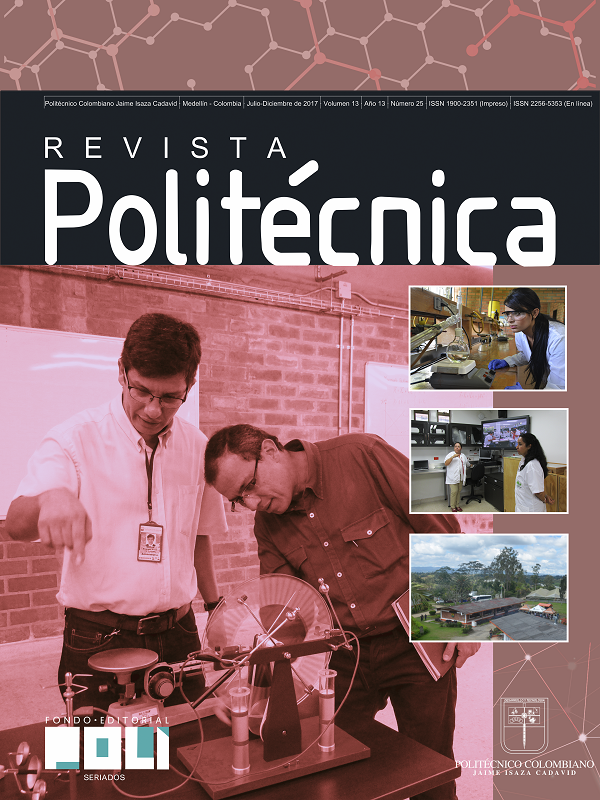Characterization of augmented reality markers for use in robotics
DOI:
https://doi.org/10.33571/rpolitec.v13n25a7Keywords:
Computer vision, Augmented reality, Markers, Robotics, Mobile RobotAbstract
In spite of the wide variety of studies and researches about augmented reality applied in robotic systems, in general terms there are not analysis around how affects the detection of markers: illumination, distances, or angles of incidence of the robot´s camera, underestimating the importance of these parameters in the representation of augmented objects, it difficult to do an objective performance comparison of the augmented reality applications in robots. This paper describes a procedure in order to analysis a set of standard augmented reality markers taking into account distances, detection angles, illumination, and the effect of marker size on the scale of augmented objects, in a way that helps the reader to determine what effect they have on the system performance, and proposing a series of recommendations from the results of technical tests in order to maintain optimal detection of markers for in-door environments.
Article Metrics
Abstract: 1886 HTML (Español (España)): 1124 PDF (Español (España)): 666 XML (Español (España)): 41PlumX metrics
References
Krevelen, V. & Poelman, R. (2010). A Survey of
Augmented Reality Technologies, Applications and Limitations. The International Journal of Virtual Reality, 9(2), 1–20.
I. Y. Chen, B. MacDonald, and B. Wunsche, “Mixed Reality Simulation for Mobile Robots,” Robot. Autom. 2009. ICRA ’09. IEEE Int. Conf., pp. 232–237, 2009.
Kevin Sebastian Kain, Susanne Stadler, Manuel Giuliani, Nicole Mirnig, Gerald Stollnberger, and Manfred Tscheligi. 2017. Tablet-Based Augmented Reality in the Factory: Influence of Knowledge in Computer Programming on Robot Teaching Tasks. In Proceedings of the Companion of the 2017 ACM/IEEE International Conference on Human-Robot Interaction (HRI '17). ACM, New York, NY, USA, 151-152.
Kozlov, et al. (2007). Towards Improving SLAM Algorithm Development using Augmented Reality. Proceedings of Australasian Conference on Robotics and Automation (ACRA) 2007, 7–17.
Luo, R. C. & Lai, C. C. (2014). Multisensor Fusion-Based Concurrent Environment Mapping and Moving Object Detection for Intelligent Service Robotics. IEEE Transactions on Industrial Electronics, 61(8), 4043–4051.
B. Yen-Hung Chen, Ian; MacDonal, Bruce; Wunsche, “Markerless Augmented Reality for RoboticHelicoptor Applications.,” Robot Vision, Lect. Notes Comput. Sci., vol. 4931, pp. 125–138, 2008.
J. BędkowskiMas and A. Masłowski, “Augmented reality approach for mobile multi- robotic system development and integration,” Tech. Komputerowe, vol. 1, pp. 15–24, 2009.
J. Carff, M. Johnson, E. M. El-Sheikh, and J. E. Pratt, “Human-robot team navigation in visually complex environments,” 2009 IEEE/RSJ Int. Conf. Intell. Robot. Syst. IROS 2009, pp. 3043–3050, 2009.
Mekni, M. & Lemieux, A. (2014). Augmented Reality : Applications , Challenges and Future Trends. Applied Computational Science Anywhere, 205–214.
S. Makris et al, "Augmented reality system for operator support in human–robot collaborative assembly". CIRP Annals - Manufacturing Technology, Ed: Elsevier, Volume 65, Issue 1, 2016, Pages 61-64
Bunz, E., Chadalavada, R T., Andreasson, H., Krug, R., Schindler, M. et al. (2016) Spatial Augmented Reality and Eye Tracking for Evaluating Human Robot Interaction. In: Proceedings of RO-MAN 2016 Workshop: Workshop on Communicating Intentions in Human-Robot Interaction
J. Mejía Bustamante and R. López Varona, “Calibración de Cámara Termográfica Fluke TI-32 Thermographic camera calibration FLUKE TI-32,” Sci. Tech. Año XIX, vol. 19, no. 1, pp. 59–66, 2014.
A. I. Barranco, S. Martínez Díaz, and Gómez.Jose, Visión Estereoscópica Por Computadora Con Matlab Y Opencv, 1st ed. Hardcover (dust-jacket), 2010.
A. Fetić and D. Jurić, “The procedure of a camera calibration using Camera Calibration Toolbox for MATLAB,” MIPRO, 2012 Proc. 35th Int. Conv., pp. 1752–1757, 2012.


 _
_






















